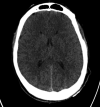Valproate-induced fatal acute hyperammonaemia-related encephalopathy in late-onset ornithine transcarbamylase deficiency
- PMID: 34035022
- PMCID: PMC8154925
- DOI: 10.1136/bcr-2020-241429
Valproate-induced fatal acute hyperammonaemia-related encephalopathy in late-onset ornithine transcarbamylase deficiency
Abstract
Ornithine transcarbamylase (OTC) deficiency is a genetic disorder of the urea cycle characterised by deficiency in the enzyme OTC, resulting in an accumulation of ammonia. Valproic acid (VPA), a commonly used medication in the treatment of neurologic and psychiatric conditions, has been known to cause episodes of acute hyperammonaemia in patients with OTC deficiency. We present the case of a 29-year-old man with a long history of non-specific psychiatric disorders, who suffered from a hyperammonaemic crisis following the administration of VPA, leading to the diagnosis of OTC deficiency. The patient's hospital course was complicated by progressive cerebral oedema, which resulted in worsening encephalopathy, seizures and death. We discuss the pathophysiology of hyperammonaemia in OTC deficiency, and various management strategies, including lactulose, levocarnitine, scavenger therapy and haemodialysis.
Keywords: adult intensive care; coma and raised intracranial pressure; metabolic disorders; neurology (drugs and medicines).
© BMJ Publishing Group Limited 2021. No commercial re-use. See rights and permissions. Published by BMJ.
Conflict of interest statement
Competing interests: None declared.
Figures
Similar articles
-
Corticosteroid-induced hyperammonaemic encephalopathy in a woman with late-onset ornithine transcarbamylase deficiency.BMJ Case Rep. 2024 May 2;17(5):e255793. doi: 10.1136/bcr-2023-255793. BMJ Case Rep. 2024. PMID: 38697679
-
Fatal hyperammonaemia due to late-onset ornithine transcarbamylase deficiency.Neth J Med. 2016 Jan;74(1):36-9. Neth J Med. 2016. PMID: 26819360
-
Valproate-induced hyperammonemia - uncovering an underlying inherited metabolic disorder: a case report.J Med Case Rep. 2018 May 17;12(1):134. doi: 10.1186/s13256-018-1666-3. J Med Case Rep. 2018. PMID: 29769109 Free PMC article.
-
[Consensus on diagnosis and treatment of ornithine trans-carbamylase deficiency].Zhejiang Da Xue Xue Bao Yi Xue Ban. 2020 Oct 25;49(5):539-547. doi: 10.3785/j.issn.1008-9292.2020.04.11. Zhejiang Da Xue Xue Bao Yi Xue Ban. 2020. PMID: 33210478 Free PMC article. Review. Chinese.
-
Genotype-Phenotype Correlations in Ornithine Transcarbamylase Deficiency: A Mutation Update.J Genet Genomics. 2015 May 20;42(5):181-94. doi: 10.1016/j.jgg.2015.04.003. Epub 2015 May 19. J Genet Genomics. 2015. PMID: 26059767 Free PMC article. Review.
Cited by
-
Diagnostic and Management Issues in Patients with Late-Onset Ornithine Transcarbamylase Deficiency.Children (Basel). 2023 Aug 9;10(8):1368. doi: 10.3390/children10081368. Children (Basel). 2023. PMID: 37628367 Free PMC article. Review.
-
Adverse effects of antiseizure medications: a review of the impact of pharmacogenetics and drugs interactions in clinical practice.Front Pharmacol. 2025 Jul 10;16:1584566. doi: 10.3389/fphar.2025.1584566. eCollection 2025. Front Pharmacol. 2025. PMID: 40709084 Free PMC article. Review.
References
-
- Lichter-Konecki U, Caldovic L, Morizono H. Ornithine Transcarbamylase Deficiency. : Adam MP, Ardinger HH, Pagon RA, . GeneReviews®. Seattle (WA): University of Washington, 2013. https://www.ncbi.nlm.nih.gov/books/NBK154378/
Publication types
MeSH terms
Substances
LinkOut - more resources
Full Text Sources
Other Literature Sources
Medical


